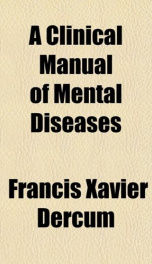a clinical manual of mental diseases

Purchase of this book includes free trial access to www.million-books.com where you can read more than a million books for free. This is an OCR edition with typos. Excerpt from book: CHAPTER III GROUP IDELIRIUM, CONFUSION, STUPOR i Delirium, the first member of this interesting group, occurs as a very common epiphenomenon of fevers, infection, intoxication, and exhaustion. It is, therefore, a condition which frequently falls under the observation of the practitioner. Once comprehended, it explains much that is met with in the allied states of confusion and stupor. We have already enumerated its principal features in the preceding chapter on Classification (see p. 27). These were illusions, hallucinations, and unsystematized delusions. To these must be added exaggerated cerebral activity and physical restlessness. Further, delirium is always of short or relatively short duration. If asked to define "delirium," we may say that it is an active mental disturbance, characterized by the presence of illusions, hallucinations, fragmentary, fleeting, unsystematized delusions, incoherence, cerebral excitement, physical restlessness, and by a relatively short course. All deliria are essentially alike, though they differ somewhat in their details. They naturally separate themselves into two groups, the febrile and the afebrile forms. The febrile deliria are those which accompany the various acute infections, the exanthemata, and the various acute visceral diseases, such as pneumonia. The afebrile deliria are those which are met with as sequelse of various infectious diseases, as a result of various intoxications, and after trauma or shock. The afebrile deliria may have their onset during the period of convalescencethepostfebrile periodof one of the exanthemata, for example, typhoid fever. Again, they may make their appearance in cases of poisoning; for instance, from alcohol or lead. Under the head of the febrile deliria we must include a delirium that h...
Info about the book
Author:
Series:
Unknown
ISBN:
0415951429
Rating:
3.5/5 (3)Your rating:
0/5
Languge:
English
Users who have this book
Users who want this book
What readers are saying
What do you think? Write your own comment on this book!
write a commentif you like a clinical manual of mental diseases try:
Do you want to exchange books? It’s EASY!
Get registered and find other users who want to give their favourite books to good hands!


